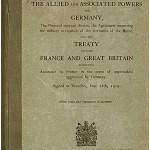7.3: The Treaty to Start All Wars
Even though the guns stopped with the armistice, the war was still technically “on” until a peace treaty could be agreed upon by the “victors,” the Allied Powers. For the first time, the United States found itself among the major European superpowers. Its president, former history professor Woodrow Wilson, had indeed learned from the lessons of history.
At the palace of Versailles, the leaders met to discuss how to make a peace that would prevent such a senseless conflict from occurring again. Wilson came with a set of principles, called The Fourteen Points, which he hoped would be the guiding ideals of the treaty. However, the European Allies came with their own ideal: crushing Germany. Germany, since its unification, had become an industrial powerhouse, and the European nations saw the treaty as their chance to prevent Germany from becoming strong again, economically or militarily.
So, putting the most important of the Points side-by-side with the actual Treaty of Versailles, we can see the “mixed bag” of results…
Point: Self-determination should be recognized and respected for every country.
1919 Treaty of Versailles: Former German colonies were placed under Allied control in mandates, including African and Asian territories/ports. Also, the Ottoman Empire was dismantled and parts were distributed to the Allies (for example, present-day Israel to Britain and Lebanon to France).
Interwar Consequence: African/Asian colonies remained under European control. Italy did not receive the territory it wanted in Africa and Japan did not receive the territory it wanted in Asia. Germany wanted to restore its empire.
Point: All economic barriers to trade should be reduced so that all countries may thrive.
1919 Treaty of Versailles: Germany must pay $33 billion in payments to the Allies for the damage of the war. (If the payments would have proceeded as planned, Germany would have finished paying off this debt in 1989!)
Interwar Consequence: The Great Depression [this connection used to be expanded in the now-deleted section 7.4].
Point: The League of Nations should be established, such that representatives from all nations can meet together and solve problems without war.
1919 Treaty of Versailles: Germany was forced to sign the treaty acknowledging that Germany and Germany alone caused World War I (the claim known as the “war-guilt clause”).
Interwar Consequence: Neither Germany nor the new U.S.S.R. was originally invited to be a part of the League. The League had no way to enforce rules, especially as the country whose president created the League (the U.S.) did not join, nor even sign the Treaty. (The U.S. would come to its own separate peace with Germany in 1921.) The League therefore was powerless to stop Italy, Germany, and Japan from their 1930s expansion into other countries.
So, the Treaty of Versailles, meant to stop the Second World War, was merely a “pause button.” Wilson suffered a stroke during a frenetic train campaign to convince Americans to sign the treaty. Generally, Americans felt that the postwar situation was Europe’s problem and they would never fight a “European war” again. Twenty years later—when a new generation of soldiers was just coming of age to be sent to war—Americans and the citizens of the world would find that the “pause button” had been hit again, thereby resuming the worldwide conflict.
